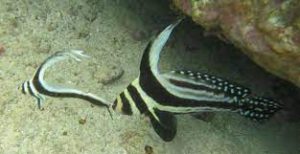
Spotted Drum Fish
The spotted drum fish, also known as Equetus punctatus, is a visually striking marine fish found in the warm coastal waters of the western Atlantic Ocean, particularly in the Caribbean Sea and the Gulf of Mexico. Here are some interesting facts about the spotted drum fish:
Appearance: The spotted drum fish has a distinctive appearance with a long, slender body and a rounded, laterally compressed shape. It has a black base coloration with numerous small, white spots covering its body, which gives it its characteristic “spotted” appearance. The dorsal fin of the spotted drum is elongated and has a filament trailing behind.
Size: Spotted drum fish are relatively small in size compared to some other fish species. They typically reach a maximum length of around 8 to 10 inches (20 to 25 centimeters) when fully grown.
Habitat: Spotted drum fish inhabit a variety of marine environments, including coral reefs, seagrass beds, rocky areas, and mangrove estuaries. They tend to prefer shallow waters with plenty of hiding places and structure, such as caves, crevices, and coral formations.
Behavior: Spotted drum fish are primarily solitary and nocturnal, spending their days hiding among rocks or coral and becoming more active at night to feed. They are relatively slow swimmers and use their elongated dorsal fin to navigate through the water. When threatened, they can create a loud drumming sound by vibrating their swim bladder, hence their name.
Feeding Habits: Spotted drum fish are carnivorous predators, feeding on small invertebrates, crustaceans, and small fish. They use their protractile mouth to capture prey, extending their jaws to create a suction force that allows them to gulp down their food.
Reproduction: Spotted drum fish are oviparous, which means they reproduce by laying eggs. They have been observed forming pairs during the mating season, with the male protecting and guarding the fertilized eggs until they hatch. The male will fan the eggs with its pectoral fins to ensure proper oxygenation.
Color Changes: The spotted drum fish has the ability to change its coloration, particularly when it feels threatened or during courtship displays. They can darken or lighten their body color, enhancing the contrast between the black base and white spots, or display a pale coloration with reduced contrast to blend with their surroundings.
Aquarium Popularity: Spotted drum fish are popular among marine aquarium enthusiasts due to their striking appearance and relatively small size. However, they require specific tank conditions, such as suitable hiding places, ample swimming space, and a well-balanced diet, to thrive in captivity.
Conservation Status: The conservation status of spotted drum fish is currently not evaluated specifically. However, like many other marine species, they face threats from habitat degradation, pollution, overfishing, and the impacts of climate change. Ensuring the conservation and sustainable management of their habitats is crucial for their long-term survival.